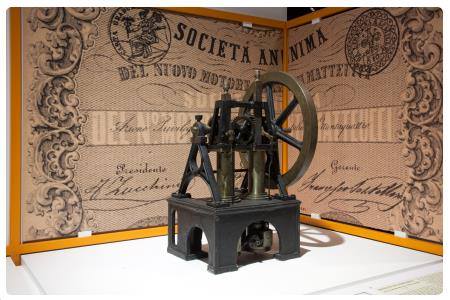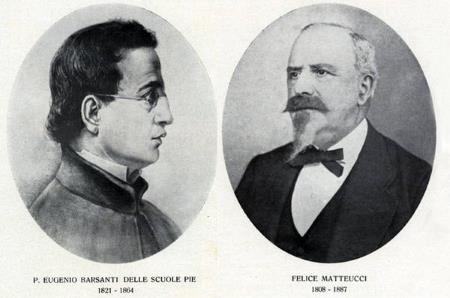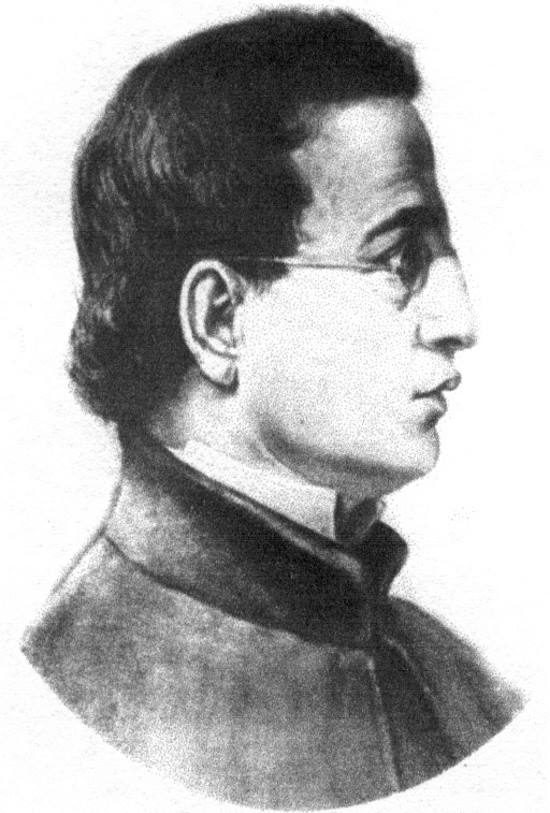|
Eugenio Barsanti - Inventor of the internal combustion
engine
|
Eugenio
Barsanti probably few have heard of Eugenio Barsanti. You
must know instead that the history of the car owes a great deal
to this priest who has lent himself to science. Its history is
curious and important, which contributed to change the world of
transport already in the mid-nineteenth century. The car, as an
invention, is about 130 years old, but without the giant steps
due to the Italian inventors, Barsanti and Matteucci,
probably would not have been born |
|
 As
opposed to what is believed, in fact, the creation of the first
four-stroke engine - that of Nikolaus Otto who, associating
himself with Karl Benz, led to the birth of Benz Velociped
dated 1886 - is the consequence of the discovery of a physics teacher
from
Pietrasanta,
Father Eugenio Barsanti, and of the developments made by these together
with an engineer from
Lucca,
Felice Matteucci. As
opposed to what is believed, in fact, the creation of the first
four-stroke engine - that of Nikolaus Otto who, associating
himself with Karl Benz, led to the birth of Benz Velociped
dated 1886 - is the consequence of the discovery of a physics teacher
from
Pietrasanta,
Father Eugenio Barsanti, and of the developments made by these together
with an engineer from
Lucca,
Felice Matteucci.
It was in fact June 6,1853,14 years earlier than the patent of Nikolaus
Otto, when Eugenio Barsanti and Felice Matteucci filed a document at the
Accademia dei Georgofili in
Florence
(there was still no patent office) describing the invention of
the first internal combustion engine in history.
Eugenio Barsanti was a priest, but also a physicist and
mathematician. He was born in 1821 in Pietrasanta,
Versilia, in the province of Lucca, with the name of
Nicolò. At the age of 17 he decided to enter the convent of
Sant' Agostino in Pietrasanta, under the academic direction
of the congregation of the Scolopi Fathers. He entered it
in order to study at the convent's scientific school. He was
ordained a priest some time later with the name of Father
Eugenio, not before having obtained his higher studies with
excellent results in all subjects and in particular in
scientific subjects.
Those of Barsanti were times of turmoil and industrial
experimentation. Steam energy was driving forward transport and
the tools needed for the infrastructure of the time. This was
how Father Eugenio, once the novitiate was over, decided to
attend the San Giovannino College, until later he was
called to the teaching of physics and mathematics in
Volterra, at the college of San Michele.
 It
was the year 1843 and, compared to the other Barsanti teachers, it was
called "the teacher", given its young age and slender build. The pupils
were in fact used to quite other things. It was in Volterra that he
developed what was initially only an idea: to use the bursting of a
mixture of air and gas to produce a new driving force. To do this,
he used a reproduction of Alessandro Volta's gun (the great
Italian physicist) also called "electrologopneumatic gun" or
simply "Volta's gun", a sort of vessel with a long neck, which he
personally had built up and which, filled with hydrogen and air and then
hermetically closed with a cork cap and a brass bar, managed to burst
through it. The bursting of the arnese was such that it was catapulted
on the ceiling, with great fright of the pupils but showing how such
spark could have triggered the bursting of the container and the
propulsion of the same. Had Barsanti created a new force, capable of
generating movement? It seems like yes: Volta had discovered detonation,
Barsanti had added a driving force to it. It
was the year 1843 and, compared to the other Barsanti teachers, it was
called "the teacher", given its young age and slender build. The pupils
were in fact used to quite other things. It was in Volterra that he
developed what was initially only an idea: to use the bursting of a
mixture of air and gas to produce a new driving force. To do this,
he used a reproduction of Alessandro Volta's gun (the great
Italian physicist) also called "electrologopneumatic gun" or
simply "Volta's gun", a sort of vessel with a long neck, which he
personally had built up and which, filled with hydrogen and air and then
hermetically closed with a cork cap and a brass bar, managed to burst
through it. The bursting of the arnese was such that it was catapulted
on the ceiling, with great fright of the pupils but showing how such
spark could have triggered the bursting of the container and the
propulsion of the same. Had Barsanti created a new force, capable of
generating movement? It seems like yes: Volta had discovered detonation,
Barsanti had added a driving force to it.
 The
college was too "narrow" for Barsanti's ingenious intuitions and destiny
wanted him to continue his experiments in physics at the Ximeniano
Observatory in Florence (now part of the National Institute of
Geophysics and Volcanology), a university level structure, where he
also had the opportunity to meet Felice Matteucci, also Lucchese,
who at that time was working on the reclamation of the Bientina lake,
and Still today, the Institute still houses the so-called "Barsanti
Matteucci", the reproduction of the first internal combustion
combustion engine, built in 1860 at the Officine Bernini in
Florence. The invention consisted of a machine that did not need to be
pressurised like steam, but needed a simple ignition to start. The two
had already led to the filing of patents in 1853 in several
European countries such as Great Britain, France, Italy and Germany, in
addition to the filing of documents at the Accademia dei Georgofili
in Florence. The agreement and collaboration between the two was such
that together they set up a company, the Company for the new engine
Barsanti and Matteucci. The
college was too "narrow" for Barsanti's ingenious intuitions and destiny
wanted him to continue his experiments in physics at the Ximeniano
Observatory in Florence (now part of the National Institute of
Geophysics and Volcanology), a university level structure, where he
also had the opportunity to meet Felice Matteucci, also Lucchese,
who at that time was working on the reclamation of the Bientina lake,
and Still today, the Institute still houses the so-called "Barsanti
Matteucci", the reproduction of the first internal combustion
combustion engine, built in 1860 at the Officine Bernini in
Florence. The invention consisted of a machine that did not need to be
pressurised like steam, but needed a simple ignition to start. The two
had already led to the filing of patents in 1853 in several
European countries such as Great Britain, France, Italy and Germany, in
addition to the filing of documents at the Accademia dei Georgofili
in Florence. The agreement and collaboration between the two was such
that together they set up a company, the Company for the new engine
Barsanti and Matteucci.
The discovery itself grandiose in scientific terms, was also
great in economic terms, considering that the steam engine
produced a force at a cost of 12 cents, compared to the two
cents needed for the production of force in the new discovery.
Despite the filing of patents, the practical recognition beyond
the Italian borders was not a great success: in other European
countries it seemed preferable to use the patent of a certain
Etienne Lenoir (franco-Belgian), even if filed a few years
later than the Italian patent. The collaboration between the two
Italian physicists did not stop and led to the creation of new
prototypes (also with the help of several workshops, including
Giovanni Battista Babacci, a mechanic from Forlì, and
Escherwyss from Zurich). In 1864, in
Liège,
in Belgium, John Cockeril's mining company decided to use
Barsanti's engine for a first series production, because it was
proven to be much more efficient than Lenoir's engine, as it was
the result of the prototype built in the Bauer workshops
in Milan.
Father Eugenio Barsanti's life was all study, physical
experimentation and ecclesiastical duty. He died of an acute
form of typhoid fever on 19 April 1864, at only 43 years
of age, while he was about to reach Seraing in Belgium,
where he was to participate in the start of series construction
of his engine. At his death Matteucci was lucky enough to pursue
the protection and commercialisation of the mechanisms designed
with Barsanti, who were in fact overwhelmed by the claim of the
invention of the internal combustion engine by Nilolaus
August Otto and several others who claimed the patent (including
Christian Reithmann in 1860 and Alphonse Beau de
Rochas in 1862).
Pietrasanta recalls Eugenio Barsanti also thanks to the writings
today kept in the archives of the library of the Galileo
Museum in Florence (formerly Institute and Museum of
History of Science). His remains, after having been
transferred several times, today rest in the
Basilica of Santa Croce
in Florence.
Copyright © Informagiovani-italia. com. Reproduction in whole
or in part, in any form, on any medium and by any means is prohibited
without written permission.
If you liked this guide and would like to help Informagiovani-italia. com
help us spread it.
Back up
Ostelli Pietrasanta Ostelli Italia
Auberges de Jeunesse Italie
Hotel Pietrasanta
Carte de Pietrasanta
Karte von Pietrasanta Mapa Pietrasanta
Map of Pietrasanta Carte
de la Toscane
Karte von Toskana
Mapa Toscana Map of
Tuscany
Carte d'Italie
Karte von Italien
Mapa Italia
Map of Italy |
